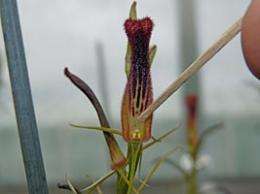Scientists find new home for threatened orchids

(PhysOrg.com) -- For many people uprooting and moving to a new home is a stressful and time consuming exercise, however it pales in comparison to the complexity of relocating native populations of rare and endangered orchids.
Scientists at the Centre for Plant Biodiversity Research (CPBR) have been researching the natural history of three rare and endangered orchids on Alum Mountain, Bulahdelah NSW, as part of a relocation project funded by the NSW Roads and Traffic Authority (RTA). The plants are being relocated to allow construction of a road bypass.
Native orchids, known for their beauty and exuberance, are quite picky when choosing a new home, needing very specific environmental conditions for their survival. To be successful, the delicate process of relocation requires detailed investigations into seed germination and species survival mechanisms.
The three orchids under investigation are: the leafless tongue orchid, Cryptostylis hunteriana; the red helmet orchid, Corybas dowlingii; and the eastern underground orchid, Rhizanthella slateri, a subterranean leafless species considered to be threatened.
A key to the success of the orchids’ translocation to alternative sites on Alum Mountain lies with understanding the special types of fungi associated with the roots of each orchid species, and the relationship of these fungi with other plants in the ecosystem. These fungi are essential for the germination of the orchid’s seeds.
"The research project's primary aim is to propagate the orchids from seed and then replant them in an undisturbed area - a very challenging undertaking," CPBR researcher Dr Chris Howard said.
"We have isolated the fungi specific for each orchid species and are in the process of running germination experiments."
To identify suitable alternative sites on Alum Mountain and secure the survival and success of the orchids in the new places, scientists will continue collecting and germinating the orchid’s seeds, and studying their flowering times, habitat preference and reproductive strategies.
Provided by CSIRO

















